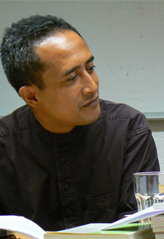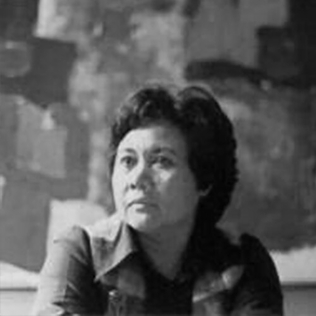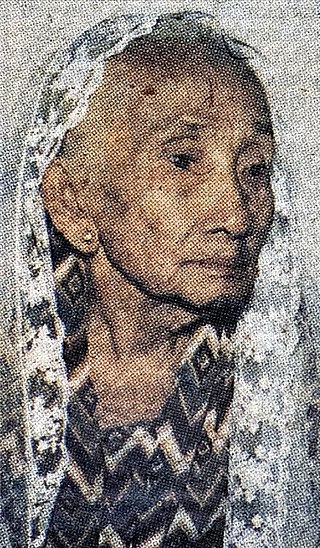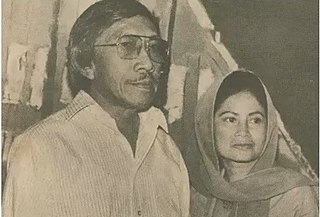
Agus R. Sarjono is an Indonesian poet and author. In 1988, he graduated from Department of Indonesian Literature of IKIP Bandung, and then finished his postgraduate program in Universitas Indonesia at the faculty of literature and cultural studies in 2002.

Mochtar Apin was an accomplished Indonesian painter, illustrator, writer and tenured lecturer who taught fine arts at the Bandung Institute of Technology, ITB.
Ivan Sagita was born in Malang 1957 and studied at the Indonesian Art Institute in Yogyakarta from 1979 to 1985. He is known as an introvert and mysterious artist, but his work of art is well known in the world of art.

Afrizal Malna, is an Indonesian activist, writer of prose, poetry, and theatrical texts.
Heri Dono is an Indonesian visual artist as artist painter, sculptor, and installation artist.
Jim Supangkat is an Indonesian sculptor, art critic and curator.

The Indonesian New Art Movement, also known as Gerakan Seni Rupa Baru(GSRB) was an art movement of young artists from Bandung and Yogyakarta against the institutional concept of Indonesian fine art (Indonesian: Seni Rupa) being limited to paintings and sculptures. The movement emerged in 1974, first organised in a protest against the judging of the Second Jakarta Painting Biennale which awarded prizes to decorative style of paintings and sculptures. The protesters published the Black December Statement (Desember Hitam) criticising the lack of social and political consciousness in Indonesian decorative art practices.
Yoes Rizal rise in Jakarta is an Indonesian contemporary artist painter. He graduated in 1985 from Art & Design at the Institut Teknologi Bandung (ITB), under Indonesian Prof. Muchtar Apin, prof. Kaboel Soeadi, Prof. Ahmad Sadali, Dr Sanento Yuliman, Umi Dachlan and Joan Sommers, American artist and master of Sumi-e.
Amrus Natalsya was an Indonesian poet, painter and wood sculpture artist. He was a political prisoner of the Suharto regime; arrested during the Transition to the New Order in 1965 for his ties to the Communist Party, he was held in prison without charge until 1973.

Indonesian painting has a very long tradition and history in Indonesian art, though because of the climatic conditions very few early examples survive, Indonesia is home to some of the oldest paintings in the world. The earliest Indonesian paintings were the rock paintings of prehistoric times, such as the petroglyphs found in places like in the caves in the district of Maros in Sulawesi, Indonesia. The Stone Age rock paintings found in Maros Cave are approximately 40,000 years old and are listed as one of the oldest paintings in the world.
Siti Adiyati Subangun, better known as Siti Adiyati, is an Indonesian contemporary artist, educator, writer, and activist. Her work explores issues of social inequality, environmental degradation, and bureaucratic corruption.

Umi Dachlan, born Umajah Dachlan,, was a pioneering Indonesian painter and an art lecturer. She graduated from the Faculty of Fine Arts and Design at the Bandung Institute of Technology ITB in 1968 as the third female graduate, where she also become the first female lecturer. Her work has been described as Abstract expressionism with a figurative Lyricism.

Marinus (Ries) Mulder was a Dutch painter, lecturer and writer. His painting style was influenced by Cubism, which he taught during his tenure as a leading lecturer of Modern Art in Indonesia.
Popo Iskandar was a painter, a prominent Indonesian art educator, literature critic and an essayist.

Kanjeng Raden Haryo Tumenggung H. Srihadi Soedarsono Adhikoesoemo was an Indonesian painter and tenured lecturer. He married Farida Srihadi, who is also an accomplished painter that studied at the Bandung Institute of Technology (ITB), as well as abroad in the Netherlands and England.

Sriwati Masmundari (1904–2005), often known simply as Masmundari, was an Indonesian visual artist known for her work with a traditional kind of lantern-painting from her birthplace Gresik called damar kurung. She became famous for it very late in life, having her first public exhibition in 1987; by the 1990s her work was featured by national magazines such as Kompas, in national art exhibitions and in the Indonesian Presidential Palace. Her work, which is sometimes described as folk art or Naïve art, often depicted vibrant scenes of celebrations, families, women at work, and so on.

Ahmad Sadali comes from a family with diversified batik and printing businesses. He was an Indonesian painter and art lecturer who is well-known for his abstract art, especially Abstract expressionism, and Cubism and Color field painting. Sadali was among the first and leading students of Ries Mulder, that represented "The Bandung School" of Indonesian art. He is considered one of the most important Indonesian modernist artists, and his works are among the highest priced Indonesian in International art markets. His signature Abstract style expresses elements of nature and spirituality in a bold yet nuanced manner.

Dolorosa Sinaga is an Indonesian sculptor, feminist and human rights activist. She was previously dean of the faculty of fine arts at the Institut Kesenian Jakarta and founder of the Somalaing Art Studio which she has operated in Jakarta since 1987. Her works appear in the National Gallery of Indonesia and internationally.
Amrizal Salayan is an Indonesian artist and sculptor.












